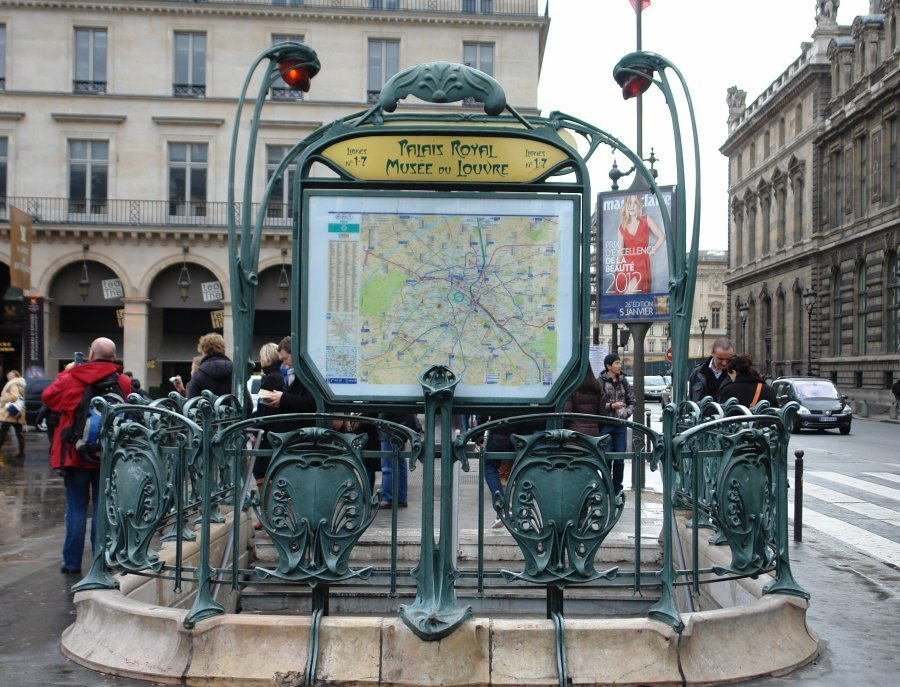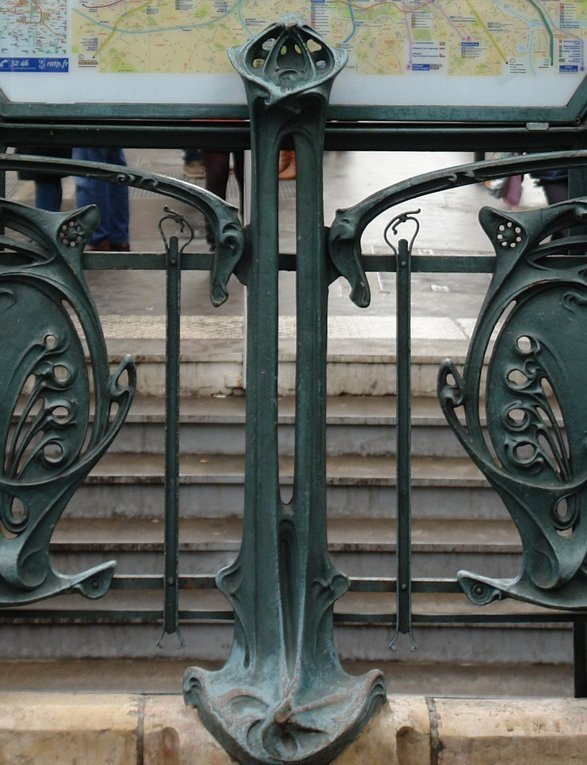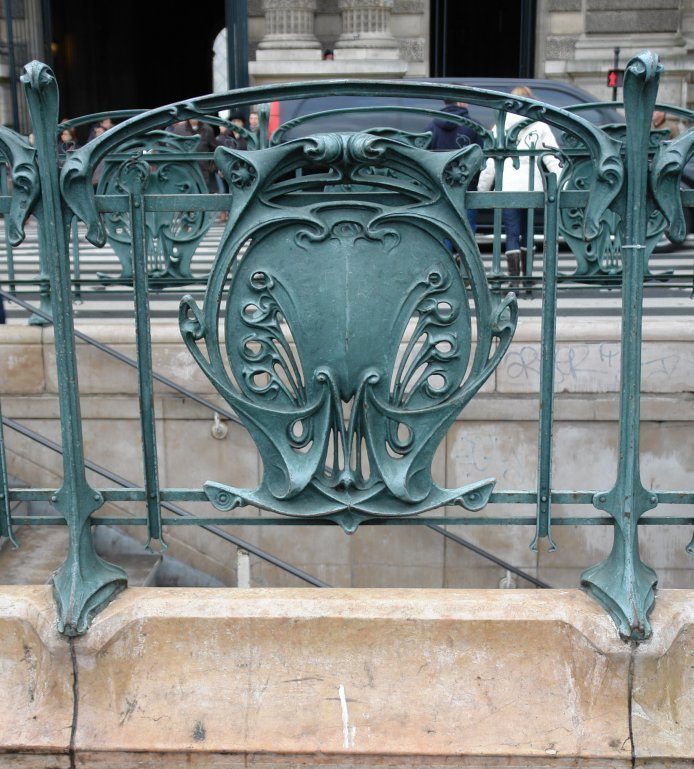log in
Enter site
Login to use Arthive functionality to the maximum
Entrance to the metro "Palais Royal - Louvre", Paris
Hector Guimard • Architecture, 1900
Description of the artwork «Entrance to the metro "Palais Royal - Louvre", Paris»
When Guimaru received an order to design what became his signature “calling card”, Paris was only the second city in the world (after London), where an underground railway was built. Guimard's design was a response to the desire to glorify and promote this new effective infrastructure, which could be clearly seen in the everyday Parisian cityscape. Guimard received this commission as a favor from the Paris City Council, which was under the control of the socialists, whose political convictions corresponded to his own sympathies.
The idea for the Metro connected the themes of socialism and industry at several levels. Guimard used cast iron parts made at the factories for the construction of entrances - no doubt, this is a bow to the workers who traveled by rail to work and helped build the network.
Guimard created three standard types of entrances: closed, awnings on three supports and open. Everywhere he used curved organic plant forms typical of the Art Nouveau style. At first glance, they seem almost seamless, but are actually constructed from several cast-iron parts, which were mass-produced at modern iron foundries east of Paris. The capabilities of cast iron were demonstrated by two unique complex closed pavilions located at the busy stations of Bastille and Etoile. These structures were often called "Chinese pagodas" because of their similarities with the eastern buildings.
Another modern innovation was red lights that illuminated many of the entrances at night, and also pulsed when the train arrived - to warn potential passengers on the street. Guimard even created a font that was used on yellow porcelain plates hanging between the lamps. Now it is known as Métropolitain.
But the forms of subway entrances were something more significant than just the clever use of modern technology. In the eyes of Guimard, the Metropolitan was a means of communication for people living in different geographical parts of the city, coming from different social strata, who received different levels of education. Moreover, Paris has traditionally been a favorite destination for immigrants and travelers from abroad. The winding stems, seed bolls and natural bulbous forms that the architect used are not identified as any particular species - and this makes them “great levelers” for everyone who uses the subway. These details are vaguely recognizable to anyone - with the exception of the letter "M", skillfully inscribed in seed boxes in the railing.
Thus, the design of Guimard played an important role in conveying complex Art Nouveau projects to a mass audience, to whom this style seemed a symbol of unattainable luxury (perhaps it still performs this function today). The design of functional facilities such as the Metro station helped fight the idea that Art Nouveau is a style designed only for wealthy clients who can afford sophisticated and time-consuming designs.
Despite the idea of universal unity, the entrances to the Metropliten, nevertheless, became one of the most notable examples of the French reaction against Art Nouveau - a style that now has become one of the national symbols, but was previously considered foreign, borrowed and foreign. Already in 1908, the entrances designed by Guimard were dismantled from the Champs Elysees because they “did not harmonize” with the classic buildings there. The Etoile station was dismantled in 1926, and the Bastille station in 1962. Separate entrances were demolished throughout the 1960s.
However, thanks to a revival of interest in Art Nouveau in the 1970s and a retrospective recognition of Guimard's artistic genius, the remaining 88 entries (presumably 167 in 1913) were transferred under the protection of the French state in 1978. They became the subject of cultural exchange between Paris and major cities around the world. Designs repeating the design of Guimard, with authentic Métropolitain plates in different years decorated the entrances to the metro in Moscow (Kievskaya station), Chicago, Montreal, Lisbon and Mexico City.
Such a physical distribution of Guimard's entrances to different points of the planet and their functional use there means that the architect’s plan has become a universal synonym for the idea of public transport. In this sense, they finally fulfilled their creator’s dream of connecting people across political, social and economic borders - on an even wider level than he could have imagined.
The idea for the Metro connected the themes of socialism and industry at several levels. Guimard used cast iron parts made at the factories for the construction of entrances - no doubt, this is a bow to the workers who traveled by rail to work and helped build the network.
Guimard created three standard types of entrances: closed, awnings on three supports and open. Everywhere he used curved organic plant forms typical of the Art Nouveau style. At first glance, they seem almost seamless, but are actually constructed from several cast-iron parts, which were mass-produced at modern iron foundries east of Paris. The capabilities of cast iron were demonstrated by two unique complex closed pavilions located at the busy stations of Bastille and Etoile. These structures were often called "Chinese pagodas" because of their similarities with the eastern buildings.
Another modern innovation was red lights that illuminated many of the entrances at night, and also pulsed when the train arrived - to warn potential passengers on the street. Guimard even created a font that was used on yellow porcelain plates hanging between the lamps. Now it is known as Métropolitain.
But the forms of subway entrances were something more significant than just the clever use of modern technology. In the eyes of Guimard, the Metropolitan was a means of communication for people living in different geographical parts of the city, coming from different social strata, who received different levels of education. Moreover, Paris has traditionally been a favorite destination for immigrants and travelers from abroad. The winding stems, seed bolls and natural bulbous forms that the architect used are not identified as any particular species - and this makes them “great levelers” for everyone who uses the subway. These details are vaguely recognizable to anyone - with the exception of the letter "M", skillfully inscribed in seed boxes in the railing.
Thus, the design of Guimard played an important role in conveying complex Art Nouveau projects to a mass audience, to whom this style seemed a symbol of unattainable luxury (perhaps it still performs this function today). The design of functional facilities such as the Metro station helped fight the idea that Art Nouveau is a style designed only for wealthy clients who can afford sophisticated and time-consuming designs.
Despite the idea of universal unity, the entrances to the Metropliten, nevertheless, became one of the most notable examples of the French reaction against Art Nouveau - a style that now has become one of the national symbols, but was previously considered foreign, borrowed and foreign. Already in 1908, the entrances designed by Guimard were dismantled from the Champs Elysees because they “did not harmonize” with the classic buildings there. The Etoile station was dismantled in 1926, and the Bastille station in 1962. Separate entrances were demolished throughout the 1960s.
However, thanks to a revival of interest in Art Nouveau in the 1970s and a retrospective recognition of Guimard's artistic genius, the remaining 88 entries (presumably 167 in 1913) were transferred under the protection of the French state in 1978. They became the subject of cultural exchange between Paris and major cities around the world. Designs repeating the design of Guimard, with authentic Métropolitain plates in different years decorated the entrances to the metro in Moscow (Kievskaya station), Chicago, Montreal, Lisbon and Mexico City.
Such a physical distribution of Guimard's entrances to different points of the planet and their functional use there means that the architect’s plan has become a universal synonym for the idea of public transport. In this sense, they finally fulfilled their creator’s dream of connecting people across political, social and economic borders - on an even wider level than he could have imagined.





